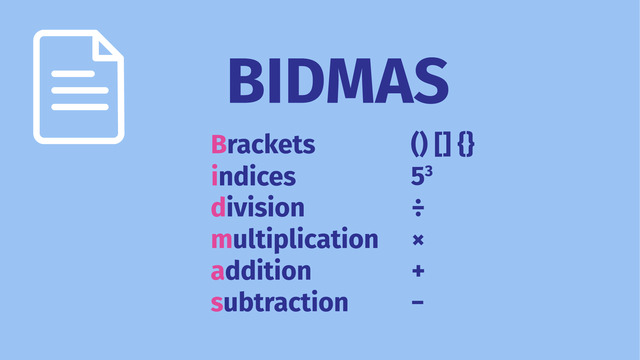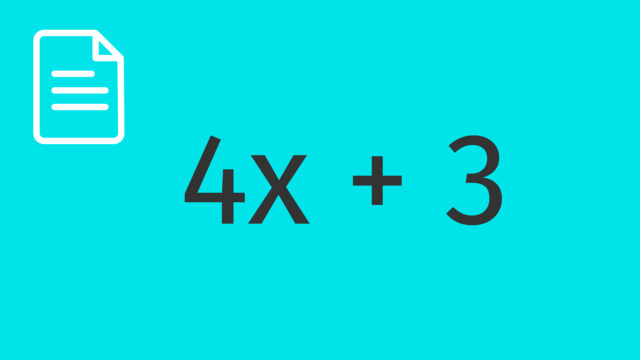Using Mathematical Terms (sum, product, factor)
Learning text on the topic Using Mathematical Terms (sum, product, factor)
Using Mathematical Terms
Welcome to the fascinating world of mathematical terms! Problem-solving and reasoning questions often use high level mathematical terms. In this text, we'll explore crucial terms like sum, product and factor. These terms are the building blocks of mathematics, and understanding them is key to mastering many mathematical concepts.
Understanding Mathematical Terms
It is important to have a deep understanding of each of the mathematical terms to understand what mathematical operation needs to be completed. Therefore, you will find a detailed explanation of sum, product and factor below.
Sum – Definition and Application
The sum is the result of adding two or more numbers together.
In a written task such as ‘The sum of two numbers is 15. If one number is 8, what is the other number?’ it is important to understand the role the word ‘sum’ plays in this problem. When we see the word sum, it doesn’t always mean find the sum, but rather it is a clue as to what needs to be done to solve the problem. Sometimes you might need to use the inverse operation, which for sum would be subtraction.
Product – Definition and Application
The product is the result of multiplying two or more numbers.
The term product refers to the result of multiplying two or more numbers or expressions. In a task like, "Find the product of 7 and 7," you must recognise that finding the product means performing multiplication. This term is crucial in understanding how to combine numbers and variables in algebraic expressions. Sometimes, the question might suggest the product is a given value, in which case you might need to use the inverse operation, division, to solve the problem.
Factor– Definition and Application
A factor is a number that divides into another number without leaving a remainder.
A factor is a number or expression that divides another number or expression evenly, with no remainder. In problems like, "List all of the factors of 24," you need to identify numbers that can perfectly divide 24 (such as 1, 2, 3, 4, 6, 8, 12, 24). Understanding factors is key in simplifying fractions, finding the greatest common factors, and solving division-related problems. It’s about recognising the building blocks that make up a number.
Factors are important, and they are applied in Prime Factorisation, Least Common Multiples, and Finding the Greatest Common Factor.
Mathematical Terms – Application
Test your understanding of mathematical terms with these questions.
Mathematical Terms Summary
Key Learnings from this Text:
Understanding mathematical terms like sum, product and factor is essential.
These terms are used in various mathematical operations and expressions.
Recognising and applying these terms correctly enhances your mathematical comprehension and problem-solving skills.
Here is a table of the terms and definitions for you to reference or make a copy of for your use.
| Term | Definition |
|---|---|
| Sum | The result of adding two or more numbers together. |
| Product | The result of multiplying two or more numbers. |
| Factor | A number that divides another number exactly, without leaving a remainder. |
Keep practising these terms in different mathematical contexts to strengthen your understanding. Remember, these terms are not just numbers or expressions; they help structure the world of mathematics!
Mathematical Terms – Frequently Asked Questions
Using Mathematical Terms (sum, product, factor) exercise
-
What do these terms mean?
HintsThe sum of 2 and 3 is 5.
The product of 2 and 3 is 6.
2 and 3 are factors of 6.
Solution- Sum - The result of adding two or more numbers.
- Product - The result of multiplying two or more numbers.
- Factor - A number that divides into another number with no remainder.
-
Find the sum of each pair of numbers.
HintsThe sum of 4 and 6 is 10.
When we are asked to find the sum, we add the numbers together.
SolutionTo find the sum, we add the numbers together.
- The sum of 24 and 35 is 59.
- The sum of 14 and 50 is 64.
- The sum of 19 and 42 is 61.
- The sum of 27, 30 and 18 is 75.
-
Find the product of each pair of numbers.
HintsTo find the product of two numbers, multiply them together.
For example, to find the product of 4 and 12, multiply 4 x 12.
4 x 12 = 48
The product of 4 and 12 is 48.
Solution12 is the product of:
- 3 and 4
- 2 and 6
- 5 and 4
- 2 and 10
- 12 and 4
- 8 and 6
-
Find the factors of the following numbers.
HintsThe factors of a number are what it can equally be divided into.
For example, the factors of 10 are: 1, 2, 5 and 10.
10 can be divided equally into all of these numbers.
Look for factor pairs to help you. Here we can see the factors and factor pairs for 28.
Solution- 12 : 1, 2, 3, 4, 6, 12
- 20 : 1, 2, 4, 5, 10, 20
- 36 : 1, 2, 3, 4, 6, 9, 12, 18, 36
-
Can you solve the problems?
HintsTo find the sum, add the numbers together.
To find the product, multiply the numbers together.
The factors of a number are what it can equally be divided into.
Solution- The sum of 11 and 9 is 20 as 11 + 9 = 20.
- The product of 3 and 4 is 12 as 3 x 4 = 12.
- The factors of 8 are 1, 2, 4 and 8 as 8 can be divided equally into 1, 2, 4 and 8.
-
Use your knowledge of mathematical terms to solve the problems.
HintsTo find the sum, add the two numbers together.
To find the product, multiply the two numbers together.
The factors of a number are what it can equally be divided into.
Solution1.) The correct answer is 53.
- 5 + 6 = 11
- 6 x 7 = 42
- 11 + 42 = 53
- The factors of 30 are: 1, 2, 3, 5, 6, 10, 15, 30
- 7 + 8 = 15
- 3 x 5 = 15
- The smallest factor of 17 is 1.
- 7 x 8 = 56
- 56 - 1 = 55
 Do you want to learn faster and more easily?
Do you want to learn faster and more easily?














